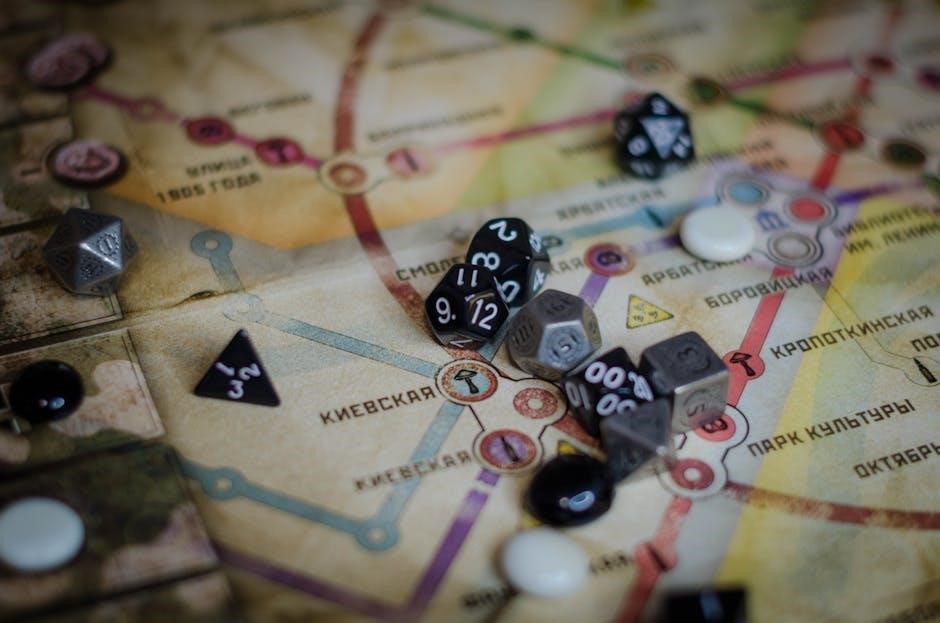Vecna in Dungeons & Dragons
Vecna’s influence in D&D is cemented by adventures like “Die Vecna Die!”‚ where players confront him directly. This high-level adventure challenges parties to thwart Vecna’s plans‚ facing his immense power and cunning.
Who is Vecna?
Vecna is an iconic archlich‚ known as one of the most powerful and evil beings in Dungeons & Dragons lore. Once a mortal scribe‚ his insatiable thirst for knowledge and power led him down a dark path‚ marked by betrayal‚ undeath‚ and near-godhood. Vecna is often depicted wielding immense magical abilities and an intellect that rivals the gods themselves. He is recognized by the artifacts that remain from his mortal existence: the Hand and Eye of Vecna. Vecna’s ultimate goal is to dominate all of reality‚ making him a formidable antagonist in any D&D campaign‚ especially in adventures like “Die Vecna Die!”.

Vecna’s Lore and History
Vecna’s history is a tapestry of dark ambition and betrayal. From his origins as a scribe to his transformation into a lich‚ his story is central to understanding his motivations in adventures like “Die Vecna Die!”.
Vecna’s Origins as a Scribe
Vecna’s path to becoming a dreaded lich began humbly as a scribe on Oerth. Despite his low social standing‚ he possessed a keen intellect and an insatiable thirst for knowledge‚ especially forbidden lore. He delved into the darkest secrets of magic‚ defying moral boundaries in his quest for power. Vecna’s early life laid the foundation for his future malevolence‚ as he educated himself‚ defying his masters and embracing dark arts. His transformation from scribe to conqueror illustrates the corrupting influence of unchecked ambition‚ a theme often explored in D&D adventures featuring him.
Vecna’s Transformation into a Lich
Driven by his lust for immortality and dominance‚ Vecna underwent a horrific transformation into a lich. This process‚ involving dark rituals and unimaginable sacrifices‚ solidified his place as one of the most powerful undead beings in the D&D multiverse. Shedding his mortal coil‚ Vecna transcended the limitations of life‚ gaining immense magical power and resilience. The transformation marked a pivotal moment‚ forever altering his existence. As a lich‚ Vecna became an unyielding force of evil‚ capable of manipulating reality and commanding legions of undead. This ascent solidified his villainous role.
Vecna’s Betrayal by Kas
Vecna’s ambition and cruelty bred distrust‚ even among his closest allies. Kas‚ his most trusted lieutenant and general‚ eventually turned against him. Fueled by the whispers of a cursed sword and resentment towards Vecna’s tyrannical rule‚ Kas confronted his master in a climactic battle. This betrayal led to Vecna’s apparent destruction‚ though fragments of his being‚ such as the Hand and Eye‚ survived. The clash between Vecna and Kas represents a central conflict in Vecna’s lore‚ highlighting the themes of ambition‚ betrayal‚ and the corrupting influence of power.

Vecna’s Powers and Abilities
Vecna possesses immense magical power and is a formidable foe. As a powerful lich‚ he has access to spells of all levels‚ legendary resistances‚ and actions. His immortality and mastery of dark magic make him a threat.
Vecna’s Mastery of Magic
Vecna’s mastery of magic is legendary‚ a testament to his insatiable thirst for arcane knowledge. He possesses an unparalleled understanding of spells from all schools‚ bending reality to his will. His spellcasting prowess is not merely academic; he wields magic with ruthless efficiency‚ weaving intricate webs of power to ensnare his foes. Vecna’s spells are often imbued with necromantic energy‚ reflecting his transformation into a lich. He commands legions of undead and can manipulate life force itself. His knowledge extends to forbidden and vile magic‚ granting him access to abilities that defy mortal comprehension. Vecna’s magical arsenal includes devastating offensive spells.
Vecna’s Legendary Resistances and Actions
Vecna’s power as a lich extends beyond mere spellcasting‚ encompassing formidable defenses and tactical prowess. His legendary resistances allow him to shrug off even the most potent spells and effects‚ making him incredibly difficult to control or harm directly. He is immune to spells of 5th level and lower‚ further bolstering his defenses against common magical attacks. Vecna’s legendary actions grant him unparalleled flexibility in combat‚ enabling him to react swiftly to changing circumstances. These actions might include casting spells‚ moving strategically‚ or disrupting his enemies’ plans. His ability to take these actions even when it is not his turn makes him a formidable opponent.
Vecna’s Immunities
As a powerful undead lich‚ Vecna possesses a range of immunities that render him resistant to many common forms of attack and control. He exhibits immunity to various conditions that would typically hinder or incapacitate other creatures. He is immune to spells of 5th level and lower‚ a testament to his mastery of magic and inherent resistance to weaker magical effects. These immunities make him an incredibly resilient adversary‚ capable of withstanding assaults that would cripple or destroy lesser beings. This reinforces Vecna’s position as a terrifying and nearly unstoppable force within the D&D multiverse.
Vecna in D&D Adventures
Vecna has appeared in several D&D adventures‚ including “Die Vecna Die!”‚ “Vecna: Eve of Ruin”‚ and the “Don’t Say Vecna” one-shot‚ each offering unique encounters with the archlich.
“Die Vecna Die!” Adventure
“Die Vecna Die!” stands as a climactic adventure where players confront Vecna’s ultimate scheme. It involves traversing multiple planes of existence‚ gathering allies‚ and uncovering secrets to weaken the lich. This high-level campaign challenges players to their limits as they face Vecna’s immense power‚ testing their strategic thinking and combat prowess.
The adventure is designed to provide a grand finale‚ allowing players to directly influence the fate of the D&D multiverse‚ as well as showcasing Vecna’s unmatched cosmic malevolence‚ demanding both cunning and courage from those who dare oppose him. Fans can match wits with one of the most powerful villains.
“Vecna: Eve of Ruin” Adventure
“Vecna: Eve of Ruin” presents another epic adventure centered around Vecna’s cosmic schemes. Optimized for characters of level 10‚ this adventure sees the players thwarting Vecna’s plans to rewrite reality. The players are about to step into a version of the Forgotten Realms.
As the heroes journey through diverse realms‚ they must gather powerful artifacts and forge alliances. Vecna stands victorious‚ his cosmic malevolence leaves Toril in ruins. The adventure culminates in a final confrontation where the fate of the multiverse hangs in the balance‚ demanding strategic brilliance and tactical skill.
“Don’t Say Vecna” One-Shot
“Don’t Say Vecna” offers a thrilling one-shot adventure‚ plunging players into a race against time within Cientia Tower. Transported to Limbo by Vecna‚ the tower holds secrets about his past‚ sought after by its scholars. The players must navigate treacherous floors and overcome magical defenses to prevent Vecna from gaining further power.
This adventure emphasizes quick thinking and resourcefulness‚ as the mere mention of Vecna can trigger unforeseen consequences. The revised Vecna statblock offers a formidable challenge. This free D&D adventure is homebrew and uses information from the Vecna Dossier.

Resources for Vecna in D&D
Players and DMs seeking Vecna resources can find stat blocks‚ the Vecna Dossier‚ and fan-made PDFs. These materials provide detailed information for incorporating Vecna into D&D campaigns and one-shots.
The Vecna Dossier
The Vecna Dossier offers a comprehensive look into the lore and statistics surrounding Vecna in D&D. Originally a D&D Beyond offering‚ fan-made PDFs and compilations have emerged‚ providing accessible resources. These documents often include stat blocks‚ lore summaries‚ and adventure hooks related to Vecna. While official PDFs may be unavailable‚ community-created content fills the gap‚ allowing players and DMs to delve deeper into Vecna’s history and power. The Dossier serves as a valuable tool for those looking to incorporate Vecna into their campaigns‚ providing essential details for crafting compelling narratives and challenging encounters.
Vecna Stat Blocks
Vecna’s stat blocks are crucial for DMs planning to pit their players against this formidable foe. These stat blocks detail Vecna’s abilities‚ spells‚ resistances‚ and legendary actions. Given Vecna’s immense power‚ his stat block reflects his status as one of D&D’s most challenging adversaries. Fan-compiled PDFs often include revised or adapted stat blocks to fit different campaign settings or power levels. When using Vecna’s stat block‚ DMs should consider the party’s level and adjust the encounter accordingly. “Die Vecna Die!” and other adventures provide specific stat blocks tailored to those scenarios.

Vecna’s Artifacts
Vecna’s artifacts‚ like the Hand and Eye‚ are iconic symbols of his power. These items often appear in adventures where his influence is strongly felt‚ such as in campaign settings where his return is imminent.
The Hand and Eye of Vecna
The Hand and Eye of Vecna are powerful artifacts steeped in dark lore‚ often sought after by characters seeking immense power at a terrible cost. Replacing one’s own body parts with these relics grants significant magical abilities but also corrupts the user. These artifacts feature prominently in “Die Vecna Die!”‚ where their potential to reshape reality is a central plot element. Obtaining and wielding the Hand and Eye presents moral dilemmas and risks‚ as they are inherently evil and tied to Vecna’s will‚ making them a dangerous asset in any campaign setting.
Vecna’s Cult
Vecna’s cult‚ a sinister organization‚ seeks to further his dark ambitions across the multiverse. Cultists‚ driven by promises of power‚ play a key role in “Die Vecna Die!”‚ attempting to bring Vecna’s plans to fruition.
Cultists of Vecna
The cultists of Vecna‚ driven by a thirst for forbidden knowledge and dark power‚ are instrumental in the events of “Die Vecna Die!”. These devoted followers serve as Vecna’s agents‚ carrying out his nefarious schemes and spreading his influence throughout the planes. They range from lowly acolytes to powerful mages‚ all united in their devotion to the Whispered One.
These cultists are willing to sacrifice anything to further Vecna’s goals. They are often found guarding sacred sites‚ performing dark rituals‚ and battling those who oppose their master. Their unwavering faith and fanatical devotion make them dangerous adversaries. They are often encountered in hidden lairs‚ ancient ruins‚ and corrupted temples‚ always working to bring about Vecna’s ultimate triumph.